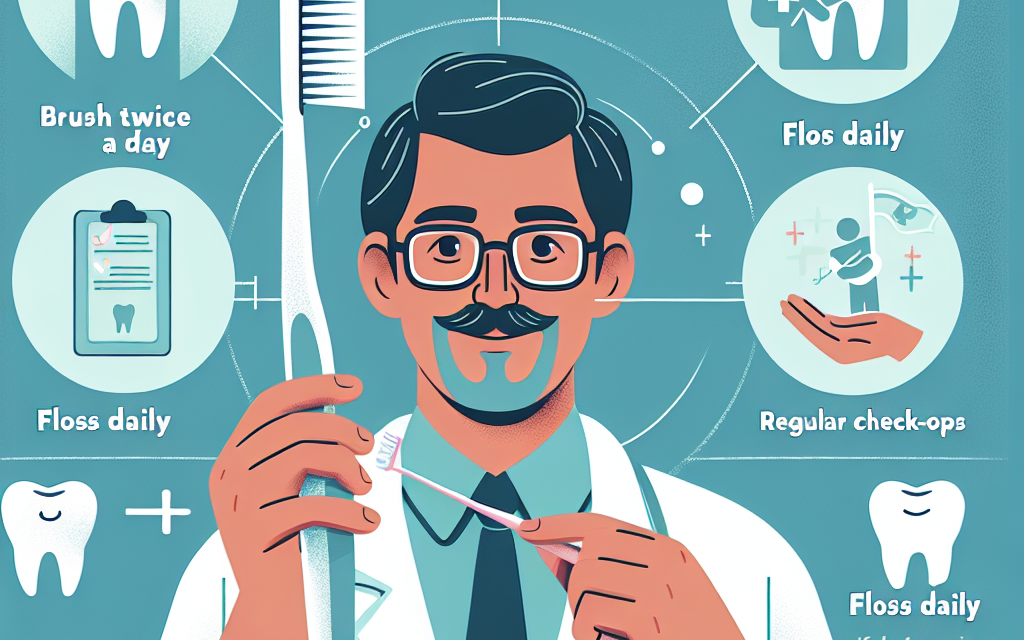Essential Tips for Preventive Dental Care from a Live Oak Dentist
Preventive dental care is crucial for maintaining oral health and preventing dental diseases. As a Live Oak dentist, I have seen firsthand the impact of good oral hygiene practices and regular dental visits on patients’ overall health. This article will provide essential tips for preventive dental care, covering various aspects such as daily oral hygiene, dietary choices, the importance of regular dental check-ups, the role of fluoride, and the significance of patient education. Each section will delve into the details, providing valuable insights and practical advice for maintaining a healthy smile.
1. Daily Oral Hygiene Practices
Daily oral hygiene is the foundation of preventive dental care. It involves a consistent routine of brushing and flossing to remove plaque and food particles that can lead to cavities and gum disease. Here are some essential practices to incorporate into your daily routine:
- Brushing Techniques: Brush your teeth at least twice a day using a fluoride toothpaste. Use a soft-bristled toothbrush and hold it at a 45-degree angle to your gums. Make gentle circular motions to clean the outer and inner surfaces of your teeth, and use a back-and-forth motion on the chewing surfaces.
- Flossing: Floss at least once a day to remove plaque and food particles from between your teeth and under the gumline. Use about 18 inches of floss, wrapping it around your middle fingers and using your thumbs and index fingers to guide it between your teeth.
- Rinsing: Consider using an antimicrobial mouthwash to help reduce plaque and gingivitis. Rinse for 30 seconds after brushing and flossing to enhance your oral hygiene routine.
According to the American Dental Association (ADA), proper brushing and flossing can reduce the risk of cavities and gum disease by up to 40%. However, many people do not brush or floss correctly, leading to ineffective cleaning. Regularly replacing your toothbrush every three to four months is also essential, as worn bristles can be less effective at removing plaque.
In addition to these practices, consider using an electric toothbrush, which can be more effective at reducing plaque and gingivitis than manual brushing. Studies have shown that electric toothbrushes can reduce plaque by 21% and gingivitis by 11% compared to manual brushes.
2. Dietary Choices for Optimal Oral Health
Your diet plays a significant role in your oral health. Certain foods can contribute to tooth decay and gum disease, while others can help strengthen your teeth and gums. Here are some dietary tips to promote optimal oral health:
- Limit Sugary Foods and Beverages: Sugar is a primary contributor to tooth decay. Bacteria in your mouth feed on sugar, producing acids that erode tooth enamel. Limit your intake of sugary snacks, sodas, and fruit juices, and opt for healthier alternatives.
- Choose Nutrient-Rich Foods: Incorporate foods rich in calcium, phosphorus, and vitamins A, C, and D into your diet. Dairy products, leafy greens, nuts, and fish are excellent sources of these nutrients, which help strengthen teeth and bones.
- Stay Hydrated: Drinking plenty of water helps wash away food particles and bacteria in your mouth. Water also helps maintain saliva production, which is essential for neutralizing acids and protecting your teeth.
Research indicates that a diet high in fruits and vegetables can reduce the risk of gum disease. For example, a study published in the Journal of Periodontology found that individuals who consumed a diet rich in fruits and vegetables had a 30% lower risk of developing periodontal disease compared to those with a less nutritious diet.
Additionally, consider chewing sugar-free gum after meals. Chewing gum stimulates saliva production, which can help neutralize acids and wash away food particles. Look for gum containing xylitol, a natural sweetener that has been shown to reduce cavity-causing bacteria in the mouth.
3. The Importance of Regular Dental Check-Ups
Regular dental check-ups are a vital component of preventive dental care. Visiting your dentist at least twice a year allows for early detection and treatment of dental issues before they become more serious. Here are some reasons why regular check-ups are essential:
- Early Detection of Dental Problems: During a dental check-up, your dentist will perform a thorough examination of your teeth, gums, and mouth. This allows for the early detection of cavities, gum disease, and other oral health issues that may not be visible to you.
- Professional Cleanings: Even with good oral hygiene practices, plaque and tartar can build up on your teeth. Professional cleanings remove this buildup, reducing the risk of cavities and gum disease.
- Oral Cancer Screenings: Regular dental visits include screenings for oral cancer, which can be life-saving if detected early. Your dentist will check for any unusual lumps, sores, or discolorations in your mouth.
According to the Centers for Disease Control and Prevention (CDC), nearly 50% of adults aged 30 and older have some form of gum disease. Regular dental check-ups can help prevent the progression of this disease and maintain your overall oral health.
Moreover, dental check-ups provide an opportunity for your dentist to offer personalized advice on improving your oral hygiene routine and dietary choices. They can also address any concerns you may have about your oral health and provide guidance on maintaining a healthy smile.
4. The Role of Fluoride in Preventive Dental Care
Fluoride is a naturally occurring mineral that plays a crucial role in preventing tooth decay. It helps strengthen tooth enamel and makes teeth more resistant to acid attacks from plaque bacteria and sugars. Here are some key points about the role of fluoride in preventive dental care:
- Fluoride Toothpaste: Using fluoride toothpaste is one of the simplest ways to protect your teeth. The ADA recommends using a toothpaste that contains fluoride to help prevent cavities.
- Fluoride Treatments: Your dentist may recommend professional fluoride treatments, especially for children and individuals at higher risk for cavities. These treatments involve applying a concentrated fluoride solution to the teeth, providing additional protection.
- Community Water Fluoridation: Many communities add fluoride to their drinking water to help reduce tooth decay. Studies have shown that community water fluoridation can reduce cavities by 25% in children and adults.
Despite the benefits of fluoride, some individuals may have concerns about its safety. However, extensive research has shown that fluoride is safe and effective when used appropriately. The CDC recognizes community water fluoridation as one of the top public health achievements of the 20th century due to its significant impact on reducing tooth decay.
In addition to its preventive benefits, fluoride can also help remineralize early stages of tooth decay, reversing damage before it progresses to a cavity. This makes fluoride an essential component of any preventive dental care plan.
5. The Significance of Patient Education
Patient education is a critical aspect of preventive dental care. Empowering patients with knowledge about oral health can lead to better hygiene practices and healthier choices. Here are some ways to enhance patient education:
- Informative Resources: Provide patients with brochures, pamphlets, and online resources that cover various topics related to oral health, including proper brushing and flossing techniques, dietary choices, and the importance of regular check-ups.
- Personalized Guidance: During dental visits, take the time to discuss each patient’s unique oral health needs and provide tailored advice. This can include recommendations for specific products, techniques, or lifestyle changes.
- Encourage Questions: Create an open environment where patients feel comfortable asking questions about their oral health. Addressing their concerns can help them feel more engaged in their care and motivated to maintain good oral hygiene.
Research shows that patients who receive education about their oral health are more likely to adhere to preventive measures. A study published in the Journal of Dental Research found that patients who received personalized oral health education were 50% more likely to improve their oral hygiene practices compared to those who did not receive education.
Furthermore, leveraging technology can enhance patient education. Consider using social media, email newsletters, or a practice website to share tips, articles, and updates about oral health. Engaging patients through these platforms can help reinforce the importance of preventive care and encourage them to take an active role in their oral health.
Conclusion
Preventive dental care is essential for maintaining optimal oral health and preventing dental diseases. By incorporating daily oral hygiene practices, making informed dietary choices, attending regular dental check-ups, utilizing fluoride, and prioritizing patient education, individuals can significantly reduce their risk of cavities and gum disease.
As a Live Oak dentist, I encourage everyone to take these essential tips to heart. Remember that prevention is always better than treatment. By investing time and effort into your oral health today, you can enjoy a healthier smile for years to come. Make preventive dental care a priority, and don’t hesitate to reach out to your dentist for personalized advice and support on your journey to optimal oral health.





